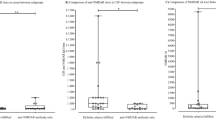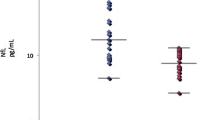Abstract
Introduction
Neurofilament light chains (NfL) have been reported as potential markers for neuronal-axonal injury in neuroinflammatory diseases. In the current study, we describe serum NfL levels as a prognostic marker for anti-N-methyl-D-aspartate receptor encephalitis (NMDARE).
Methods
Serum levels of NfL of 64 patients with anti-NMDARE and 84 healthy controls were measured by Simoa. The anti-NMDAR Encephalitis One-Year Functional Status (NEOS) score, Modified Rankin Scale (mRS) scores, and clinical and cerebrospinal fluid parameters were evaluated in patients with anti-NMDARE. Meanwhile, we performed a receiver-operator characteristic analysis to assess the power of the serum NFL in predicting the 1-year functional status.
Results
Serum NfL levels were significantly elevated in patients with anti-NMDARE compared to healthy controls (p < 0.001, padjusted < 0.001), especially in patients with severe impairments (mRS > 3 vs ≤ 3, p = 0.035) or with limited response to treatment (vs. favorable outcome, p = 0.011). Serum NFL was positively associated with the initial admission mRS (r = 0.23, p = 0.072) and 1-year mRS (r = 0.29, p = 0.018). The AUC of serum NfL and NEOS score for 1-year poor functional status was 0.697 (95% CI 0.527–0.866, p = 0.011), 0.753 (95% CI 0.616–0.890, p = 0.001), respectively. Furthermore, AUC of the combination of serum NfL and NEOS was 0.815 (95% CI 0.680–0.950, p < 0.001).
Conclusion
Our findings show that serum NfL levels evaluated in anti-NMDAR encephalitis may be a good predictor of the risk of 1-year poor functional status.



Similar content being viewed by others

Data availability
The data that support the findings of this study are available from the corresponding author upon reasonable request.
References
Dalmau J, Armangue T, Planaguma J et al (2019) An update on anti-NMDA receptor encephalitis for neurologists and psychiatrists: mechanisms and models. LANCET NEUROL 18:1045–1057
Dalmau J, Graus F (2018) Antibody-mediated encephalitis. N Engl J Med 378:840–851
Florance NR, Davis RL, Lam C et al (2009) Anti-N-methyl-D-aspartate receptor (NMDAR) encephalitis in children and adolescents. ANN NEUROL 66:11–18
Disanto G, Barro C, Benkert P et al (2017) Serum neurofilament light: a biomarker of neuronal damage in multiple sclerosis. ANN NEUROL 81:857–870
Kapoor R, Smith KE, Allegretta M et al (2020) Serum neurofilament light as a biomarker in progressive multiple sclerosis. Neurology 95:436–444
Chang X, Huang W, Wang L et al (2021) Serum Neurofilament light and GFAP are associated with disease severity in inflammatory disorders with aquaporin-4 or myelin oligodendrocyte glycoprotein antibodies. FRONT IMMUNOL. 12:647618
Mariotto S, Gajofatto A, Zuliani L et al (2019) Serum and CSF neurofilament light chain levels in antibody-mediated encephalitis. J NEUROL 266:1643–1648
Macher S, Zrzavy T, Hoftberger R et al (2021) Longitudinal measurement of cerebrospinal fluid neurofilament light in anti-N-methyl-D-aspartate receptor encephalitis. EUR J NEUROL 28:1401–1405
Shu Y, Qiu W, Zheng J et al (2019) HLA class II allele DRB1*16:02 is associated with anti-NMDAR encephalitis. J Neurol Neurosurg Psychiatry 90:652–658
Shu Y, Chen C, Chen Y et al (2018) Serum complement levels in anti-N-methyl-d-aspartate receptor encephalitis. EUR J NEUROL 25:178–184
Titulaer MJ, McCracken L, Gabilondo I et al (2013) Treatment and prognostic factors for long-term outcome in patients with anti-NMDA receptor encephalitis: an observational cohort study. LANCET NEUROL 12:157–165
Balu R, McCracken L, Lancaster E et al (2019) A score that predicts 1-year functional status in patients with anti-NMDA receptor encephalitis. Neurology 92:e244–e252
Giovanni M. Marchetti, Mathias Drton, Sadeghi K. ggm: Graphical Markov Models with Mixed Graphs. R package version 2.5. https://CRAN.R-project.org/package=ggm. 2020
Team RC. “A language and environment for statistical computing.” R Foundation for Statistical Computing, Vienna, Austria. URL http://www.R-project.org/. 2013
Peng Y, Dai F, Liu L et al. Validation of the NEOS score in Chinese patients with anti-NMDAR encephalitis. Neurol Neuroimmunol Neuroinflamm. 2020;7
Funding
This study was supported by the Guangdong Basic and Applied Basic Research Foundation (2021A1515010393), National Natural Science Foundation of China (NO.82071343, NO.81701188), and the First Major Talent Project of the Third Affiliated Hospital of Sun Yat-sen University (P02099).
Author information
Authors and Affiliations
Contributions
Conception and design of the study: Yaqing Shu, Wei Qiu. Acquisition and analysis of data: Xiaoyu Ma, Yaxin Lu, Fuhua Peng, Yuge Wang, Xiaobo Sun, Wenjing Luo, Shishi Shen, Zifeng Liu, Wei Qiu. Drafting of the text or preparing the figures: Yaqing Shu. Polishing of the text: Allan G. Kermode.
Corresponding authors
Additional information
Publisher's Note
Springer Nature remains neutral with regard to jurisdictional claims in published maps and institutional affiliations.
Rights and permissions
About this article
Cite this article
Ma, X., Lu, Y., Peng, F. et al. Serum NfL associated with anti-NMDA receptor encephalitis. Neurol Sci 43, 3893–3899 (2022). https://doi.org/10.1007/s10072-021-05838-3
Received:
Accepted:
Published:
Issue Date:
DOI: https://doi.org/10.1007/s10072-021-05838-3



